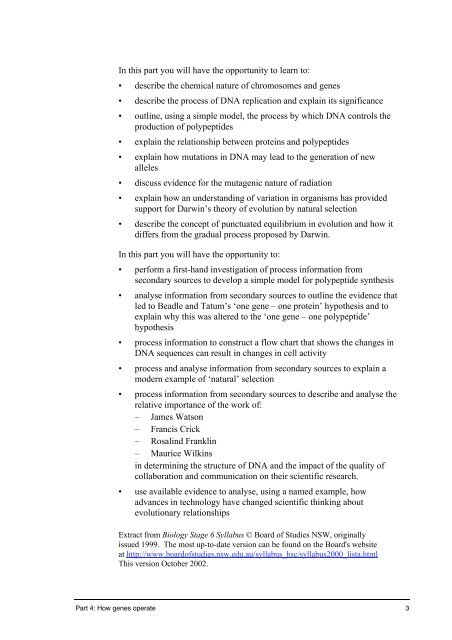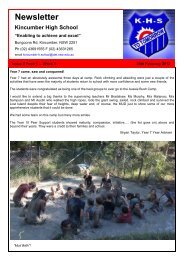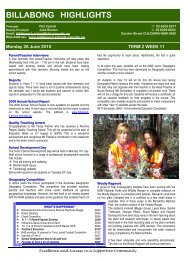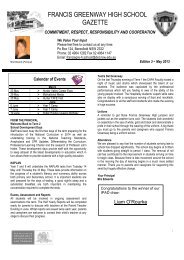- Page 1 and 2:
Gill Sans BoldBiologyHSC CourseStag
- Page 3 and 4:
ContentsModule overviewOutcomes ...
- Page 5 and 6:
Module overviewDNA is often called
- Page 7 and 8:
IconsThe following icons are used w
- Page 9 and 10:
genotypegill slitshaploidheterozygo
- Page 11:
Gill Sans BoldBiologyHSC CourseStag
- Page 14 and 15:
IntroductionPopular culture often d
- Page 16 and 17:
In this part you will have the oppo
- Page 18 and 19:
Whichever way the environment chang
- Page 20 and 21:
3 A number of scenarios to do with
- Page 22 and 23:
An open-ended investigation of natu
- Page 24 and 25:
On green backgroundOn neutral backg
- Page 26 and 27:
Evidence for evolutionFor any real
- Page 28 and 29:
The fossil records have revealed a
- Page 30 and 31:
ProcedureThe span of the cheek teet
- Page 32 and 33:
1 Why can’t you join two or three
- Page 34 and 35:
Are all the relationships proposed
- Page 36 and 37:
However, this view of evolution is
- Page 38 and 39:
N3323NearcticPalaearcticOrientalNeo
- Page 40 and 41:
Biogeographic distributionsThere ar
- Page 42 and 43:
Vestigial structuresThose structure
- Page 44 and 45:
BiochemistryThe building blocks of
- Page 46 and 47:
By the middle and toward the end of
- Page 48 and 49:
mammalreptilefishThe diagrams above
- Page 50 and 51:
The evolution of evolutionA require
- Page 52 and 53:
40 Blueprint of life
- Page 54 and 55:
ecame abundant, evolving to take ad
- Page 56 and 57:
Case study 2: Southern Antarctic Be
- Page 58 and 59:
Carolus Linnaeus (1707-1778)A Swedi
- Page 60 and 61:
Charles Darwin (1809-1882)Charles D
- Page 62 and 63:
Example 2: A view of a nineteenth c
- Page 64 and 65:
3 a) Adaptations for an area drying
- Page 66 and 67:
Your answers for the following ques
- Page 68 and 69:
56 Blueprint of life
- Page 70 and 71:
Exercise 1.2: An open-ended investi
- Page 72 and 73:
Exercise 1.5: Comparative anatomya)
- Page 74 and 75:
) Compare the structure of the pent
- Page 76 and 77:
Exercise 1.7: The evolution of evol
- Page 78:
Gill Sans BoldBiologyHSC CourseStag
- Page 81 and 82:
IntroductionThe idea that offspring
- Page 83 and 84:
Gregor Mendel andhis workIt require
- Page 85 and 86:
Dominant and recessive traitsMendel
- Page 87 and 88:
Mendel’s conclusionsFrom his inve
- Page 89 and 90:
Here is a diagram to represent this
- Page 91 and 92:
Another exampleThe diagram below re
- Page 93 and 94:
Another reason for the absence of a
- Page 95 and 96:
• crossing a pure breeding recess
- Page 97 and 98:
Genotype and phenotypeIn Mendel’s
- Page 99 and 100:
Use Punnett squares to solve the fo
- Page 101 and 102:
Investigatinghuman variationYou hav
- Page 103 and 104:
DiscussionCompare your features wit
- Page 105 and 106:
4 Repeat step 2 for the next genera
- Page 107 and 108:
Using a pedigree to investigatea tr
- Page 109 and 110:
Using a pedigree to makepredictions
- Page 111 and 112:
Dominant traits can get a bit trick
- Page 113 and 114:
The disadvantages of hybridisation
- Page 115 and 116:
3 Yes, the ratios for traits in all
- Page 117 and 118:
2+BBbBbBbbBbBbThe person will be br
- Page 119 and 120:
3 a) Both parents must be heterozyg
- Page 121 and 122:
) Mendel’s research was not recog
- Page 123 and 124:
Exercise 2.3: Mr Punnett and his sq
- Page 125 and 126:
Exercise 2.4: Using a pedigree to m
- Page 127:
Gill Sans BoldBiologyHSC CourseStag
- Page 130 and 131:
2 Blueprint of life
- Page 132 and 133:
Hopefully you started growing your
- Page 134 and 135:
Sutton and BoveriRead the following
- Page 136 and 137:
Here are three homologous pairs of
- Page 138 and 139:
If you matched all the pairs of hum
- Page 140 and 141:
1 Compare the body cell and gamete.
- Page 142 and 143:
The duplication of chromosomesChrom
- Page 144 and 145:
The final separation of chromosomes
- Page 146 and 147:
Increasing variation - crossing ove
- Page 148 and 149: ororThe possible gametes are shown
- Page 150 and 151: You should now have a pair of pipe
- Page 152 and 153: In the next step, the duplicated ch
- Page 154 and 155: Modelling crossing overNow repeat t
- Page 156 and 157: Take the challenge!Earlier in this
- Page 158 and 159: When sex cellscombineYou have seen
- Page 160 and 161: 3 Predict the likelihood of genes A
- Page 162 and 163: +Y_________________________________
- Page 164 and 165: uncommon for both X chromosomes tha
- Page 166 and 167: parentsF12childrenF 13 45 6 7 8 9gr
- Page 168 and 169: A good example of incomplete domina
- Page 170 and 171: Human heightOne of the impressive a
- Page 172 and 173: ResultsPlant Height (cm) control gr
- Page 174 and 175: 46 Blueprint of life
- Page 176 and 177: Gamete template48 Blueprint of life
- Page 178 and 179: 50 Blueprint of life
- Page 180 and 181: Gamete template52 Blueprint of life
- Page 182 and 183: Morgan and his investigations of Dr
- Page 184 and 185: The final separation of chromosomes
- Page 186 and 187: ) Half of the children will be girl
- Page 188 and 189: Exercise 3.2: Take the challenge!a)
- Page 190 and 191: Exercise 3.3: Sex leads to varietya
- Page 192 and 193: RrRRrrRr RrIs this trait co-dominan
- Page 194: Gill Sans BoldBiologyHSC CourseStag
- Page 197: IntroductionPeople once explained t
- Page 201 and 202: The main people responsible for the
- Page 203 and 204: The structure of DNADNA is a chemic
- Page 205 and 206: The transmissionof genesDNA is the
- Page 207 and 208: 12 Blueprint of life
- Page 209 and 210: 14 Blueprint of life
- Page 211 and 212: 16 Blueprint of life
- Page 213 and 214: The ‘one gene - one enzyme’ the
- Page 215 and 216: There are also two types of RNA, ea
- Page 217 and 218: Translation occurs on organelles in
- Page 219 and 220: The genetic code for amino acidsThe
- Page 221 and 222: What is the role of DNA?Hopefully,
- Page 223 and 224: always work. Changes to DNA can be
- Page 225 and 226: 2 Why can mutations lead to new all
- Page 227 and 228: environment. That feeling is now re
- Page 229 and 230: acteria multiply very quickly and a
- Page 231 and 232: The fossil record contains many lar
- Page 233 and 234: suggesting that chimpanzees should
- Page 235 and 236: sugarnitrogen basephosphateA nucleo
- Page 237 and 238: TranscriptionDNAUAA C T G G AU AG C
- Page 239 and 240: Exercise 4.2: DNA duplicationa) As
- Page 241 and 242: Exercise 4.4: Polypeptide productio
- Page 243 and 244: Exercise 4.6: Sickle cell anaemiaSi
- Page 245 and 246: c) Give a named example of a classi
- Page 248 and 249:
Gill Sans BoldContentsIntroduction
- Page 250 and 251:
Gill Sans BoldIntroductionIf you ar
- Page 252 and 253:
Gill Sans BoldArtificial selectionT
- Page 254 and 255:
Gill Sans BoldHuman reproductive te
- Page 256 and 257:
Gill Sans BoldArtificial pollinatio
- Page 258 and 259:
Gill Sans Bold1donordonor cellA bod
- Page 260 and 261:
Gill Sans BoldTransgenic speciesDur
- Page 262 and 263:
Gill Sans BoldWhen a gene that prod
- Page 264 and 265:
Gill Sans BoldBt cottonBt cotton ha
- Page 266 and 267:
Gill Sans BoldGenetics and ethicsSc
- Page 268 and 269:
Gill Sans BoldGM products and label
- Page 270 and 271:
Gill Sans BoldAdditional resourcesT
- Page 272 and 273:
Gill Sans BoldAt present, the cotto
- Page 274 and 275:
Gill Sans BoldSuggested answersArti
- Page 276 and 277:
Gill Sans BoldExercises - Part 5Exe
- Page 278 and 279:
Gill Sans BoldExercise 5.2: Transge
- Page 280 and 281:
Gill Sans BoldExercise 5.3: Genetic
- Page 282 and 283:
Gene Technology Information Service
- Page 284 and 285:
Gene Technology Information Service
- Page 286 and 287:
Gene Technology Information Service
- Page 288 and 289:
Gene Technology Information Service
- Page 290 and 291:
Gene Technology Information Service
- Page 292 and 293:
Gene Technology Information Service
- Page 294 and 295:
Gene Technology Information Service
- Page 296:
Gill Sans BoldBiologyHSC CourseStag
- Page 299 and 300:
IntroductionAt this stage you shoul
- Page 301 and 302:
Check your skillsHow confident are
- Page 303 and 304:
Test your skillsTest your skills by
- Page 305 and 306:
6 The following base sequence of DN
- Page 307 and 308:
12 Describe how amino acids, polype
- Page 309 and 310:
c) Would you expect all populations
- Page 311 and 312:
21 Histones are proteins that are e
- Page 313 and 314:
24 In pea pods, some pods are green
- Page 315 and 316:
Notice that blood groups A and B ca
- Page 317 and 318:
The marking guidelines for the ques
- Page 319 and 320:
The standard that you need to achie
- Page 321 and 322:
DNAA copy of part of a DNA code ist
- Page 323 and 324:
d) Crossing over results in a great
- Page 325 and 326:
a) competition for resources.______
- Page 327 and 328:
Part 2 - Patterns of inheritance1 O
- Page 329 and 330:
3 Explain the role of gamete format
- Page 331 and 332:
2 Outline, using a simple model, th
- Page 333 and 334:
6 Explain how an understanding of t
- Page 335 and 336:
Student evaluation of the moduleNam
















